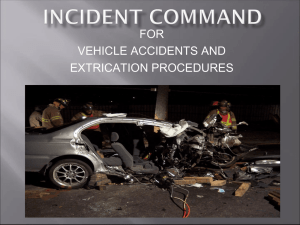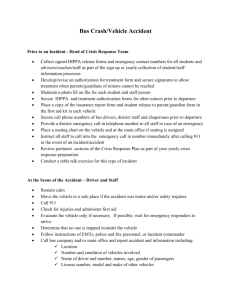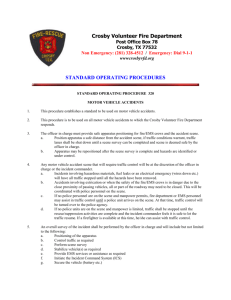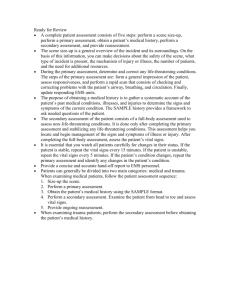Automobile Accidents - Mechanicsville Volunteer Fire Department
advertisement
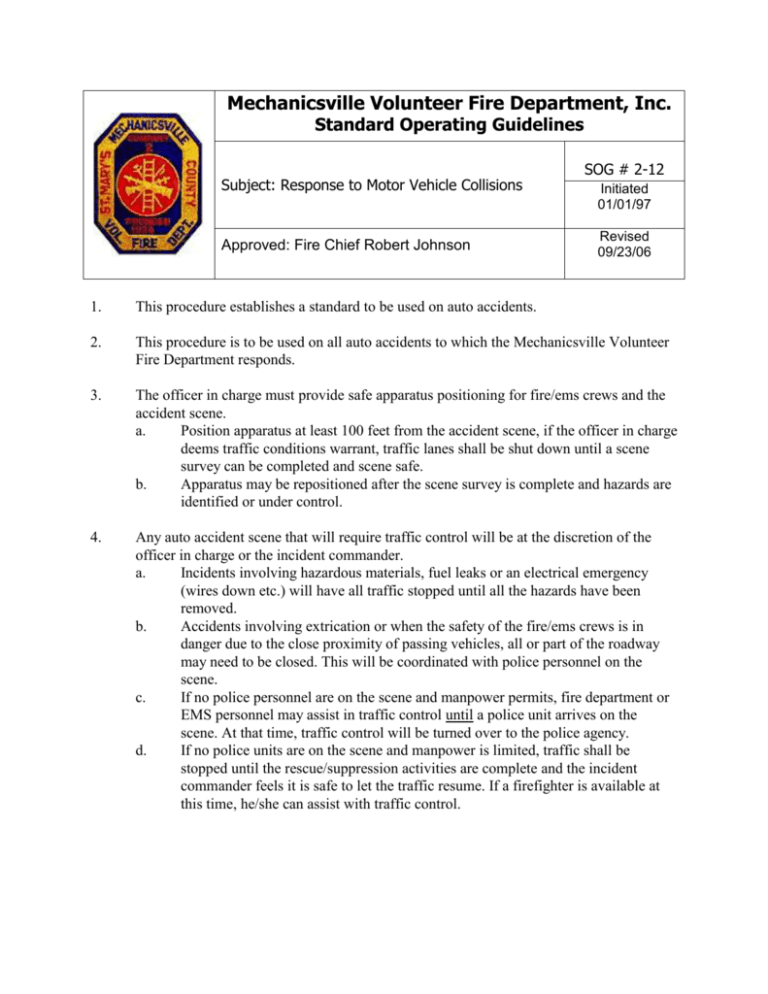
Mechanicsville Volunteer Fire Department, Inc. Standard Operating Guidelines Subject: Response to Motor Vehicle Collisions Approved: Fire Chief Robert Johnson SOG # 2-12 Initiated 01/01/97 Revised 09/23/06 1. This procedure establishes a standard to be used on auto accidents. 2. This procedure is to be used on all auto accidents to which the Mechanicsville Volunteer Fire Department responds. 3. The officer in charge must provide safe apparatus positioning for fire/ems crews and the accident scene. a. Position apparatus at least 100 feet from the accident scene, if the officer in charge deems traffic conditions warrant, traffic lanes shall be shut down until a scene survey can be completed and scene safe. b. Apparatus may be repositioned after the scene survey is complete and hazards are identified or under control. 4. Any auto accident scene that will require traffic control will be at the discretion of the officer in charge or the incident commander. a. Incidents involving hazardous materials, fuel leaks or an electrical emergency (wires down etc.) will have all traffic stopped until all the hazards have been removed. b. Accidents involving extrication or when the safety of the fire/ems crews is in danger due to the close proximity of passing vehicles, all or part of the roadway may need to be closed. This will be coordinated with police personnel on the scene. c. If no police personnel are on the scene and manpower permits, fire department or EMS personnel may assist in traffic control until a police unit arrives on the scene. At that time, traffic control will be turned over to the police agency. d. If no police units are on the scene and manpower is limited, traffic shall be stopped until the rescue/suppression activities are complete and the incident commander feels it is safe to let the traffic resume. If a firefighter is available at this time, he/she can assist with traffic control. 5. An overall survey of the incident shall be performed by the officer in charge and will include but not limited to the following: a. Positioning of the apparatus b. Control traffic as required c. Perform scene survey d. Stabilize vehicle(s) as required e. Provide EMS services or assistance as required f. Initiate the Incident Command System (ICS) g. Secure the vehicle (battery etc.) 6. Any vehicle that is occupied with patients to be treated or is in an unsafe situation shall be stabilized. a. Stabilize vehicles as required. b. Stabilization shall be performed on vehicles in unstable situations, such as on their side, roof or on uneven ground. c. Stabilization may include step chocks, wheel chocks, cribbing or securing with a winch or rope. d. A Holmatro Secunet Safety Net will be applied to all steering wheels with an air bag that HAS NOT been deployed with a subject still in the vehicle. This will include a subject that is seated any where in the vehicle not just behind the steering wheel. This is for the safety of the rescuers and the victims. e. If more than two vehicles are involved than the two worst vehicles will have the Safety Nets applied as order by the Officer in charge. This procedure may be done by the subject assign to stabilization or by another member if crew size allows. f. Vehicle ignition system must be turned off after all doors have been unlock and windows have been put down if power is needed, parking brake set and transmission in park or in neutral. 7. When operations require medical treatment by fire department personnel, the officer shall use the following protocol. a. Perform scene survey b. If the engine company arrives on the scene prior to ems, the officer in charge shall assign an EMT or First Responder to do a triage on the patient(s) and initiate BLS until EMS arrives, at which time patient care will be turned over to the arriving EMS crew. c. Stabilization shall be done on each vehicle that the occupants are still inside before any fire/ems personnel gain entry into the vehicle. c. If EMS needs assistance from the fire department, an EMT or First Responder will be supplied to them at the discretion of the operations officer (who will take into consideration manpower for suppression/rescue activities). 8. When arriving on the scene of an auto accident with no apparent hazards, the officer shall; a. Position apparatus b. Control traffic c. d. e. f. g. Complete a scene survey Stabilize vehicles Provide EMS services or assistance as required Initiate the Incident Command System (ICS) Secure the vehicle (battery etc.) 9. The officer when given a report of a subject or subject(s) trapped shall; a. Position apparatus (keeping in mind the use of the rescue tool) b. Control traffic c. Complete scene survey d. Pull “trash line” or 1 3/4" attack line for stand-by e. Stabilize vehicles f. Provide EMS services or assistance as required g. Initiate the Incident Command System (ICS) h. The engine shall be positioned at the discretion of the incident commander. NOTE: Consideration shall be given that the vehicle is not positioned too close to the scene and provides a suitable working area for the rescue tools. g. All hydraulic rescue tools shall be removed from apparatus, properly connected and operated to ensure correct operations. Hydraulic tools and hand tools should be staged in a tool staging area (preferably on the green tarp that is on the engine) and should be placed in the outer action circle. h. Under the direction of the operations/extrication officer, extrication should be coordinated with EMS personnel to ensure the safety of all occupants in the vehicle. During extrication, blankets, small backboards etc. shall be used to protect the occupants. i. No fire personnel will be permitted to be near the extrication site unless they are protected by full personal protective equipment (boots, gloves, coat, pants, helmet and eye protection). NOTE: EMS personnel are well informed, through training about proper protective equipment. The fire department incident commander shall be informed of EMS personnel not in proper protective equipment and determine if they need to be removed from the scene. j. If vehicle reconstruction is not to be performed by a police agency, then secure the battery if the vehicle is to be towed. k. At the termination of the incident all rescue tools shall be cleaned, re-fueled and readied for service. 10. When arriving at an auto accident with fuel spilled/leaking, the officer shall due the following: a. Pull the “foam line” stand-by b. If the safety of any crew, EMS or the patient is jeopardized, foam the area with AFFF and continue to monitor the foam blanket. c. No fire department or EMS personnel will be permitted in the hot zone without full turnout gear if foam operations are in progress. d. If only a small leak is present and foam operations are not needed the leak will be e. contained and absorbed (with sorbent “C” or “Kitty Litter”) and disposed of by the person(s) responsible for the leak/spill. The engine will remain for stand-by until all hazards have been removed and the leak has been removed from the scene. 11. For auto accidents involving wires down or a damaged transformer, the officer shall: a. Position apparatus at least one pole past a good standing one in case of wire failure or snapback. If wires are down near the travel portion of the road, the traffic will be stopped until deemed safe by SMECO and the incident commander. b. Request SMECO to respond while en route if you have been given any indications electric lines are involved. c. Initiate the Incident Command System (ICS) d. A scene survey shall be done taking into consideration that ALL WIRES will be assumed LIVE until SMECO confirms that they are otherwise. e. If wires are on or near a vehicle do not permit any person(s) to go near or leave the vehicle involved. Communicate the hazard to the vehicle occupants. f. Secure the vehicle (battery etc.) 12. Any incident involving hazardous materials the officer shall follow the following procedure: a. Position apparatus at a safe distance, uphill and upwind of the incident. Close down all roadways to the incident location. b. Initiate the Incident Command System (ICS). Call for a hazmat team if there is not one already en route. c. Use binoculars to try to do a scene survey. (try to identify materials involved, conditions of occupants etc.) d. Isolate and deny entry into warm zone until a hazmat team arrives and starts the hazmat operations. 13. For crowd control at the scene of an automobile accident, the officer shall follow the following procedure. a. At the discretion of the officer in charge, fire line tape will be used to assist in crowd control. If bystanders do not obey the fire line tape, consult police for assistance. b. At the discretion of the officer in charge, fire tape will be used to assist in assuring the privacy of the patient(s) and to ensure the safety of the bystanders. If necessary, a salvage cover will be held up to block view of bystanders. 14. When the situation at an accident scene requires a helicopter transport, the EMS command shall request a helicopter via the incident commander. a. EMS command shall get any pertinent patient information and report to the incident commander who will relay it to the helicopter responding. EMS command may relay information directly to the helicopter if they are available to do so. b. If the engine company on the scene is committed and cannot handle the landing c. site, a second engine shall be requested to respond. If the Mechanicsville V.F.D. cannot respond with the second engine, then a request for the next due must be made. Refer to the SOP for landing site operations for further information. 15. To stop any unsafe action that is taking place or about to take place the term “STOP/FREEZE” commands all persons to stop and correct the unsafe action. 16. This section will establish procedures for an accident involving a school bus. a. Advise Emergency Operations Center (EOC) as soon as possible the following information: the bus number, the seriousness and number of injuries. b. All students are to be evaluated by at least an EMT. c. All students that are injured are to be transported to the closest appropriate hospital. d. Students that are not transported must meet the following criteria: 1) Must have been evaluated by EMS 2) The evaluating EMT, the student and medical command must all agree the student does not need transport or to be checked by a physician. 3) A St. Mary’s County Public School Transportation representative or representative of the Parochial Schools must be physically on the scene and willing to take responsibility for the students not transported. If the representative is not willing to take custody of any individual or group of students, those students are to be transported to a hospital for evaluation by a physician. e. All students transported to a hospital are to be transported by EMS vehicles. f. Students not transported are to be placed in one group and their names, age and sex be put on a Maryland MAIS additional narrative sheet signed by the attending representative. g. At NO TIME are the students released to the parents or guardian. h. All parents/guardians that show up on the scene shall be assembled in a group and an EMS representative be assigned to them to explain policy and keep them advised of the situation as best as possible. i. The incident commander shall set up a scene perimeter and have the perimeter marked by fire line tape. j. Once initial overall assessment has been made the incident commander shall notify the EOC of the approximate number of students to be transported and their age bracket (elementary, middle, high school or special education students).
